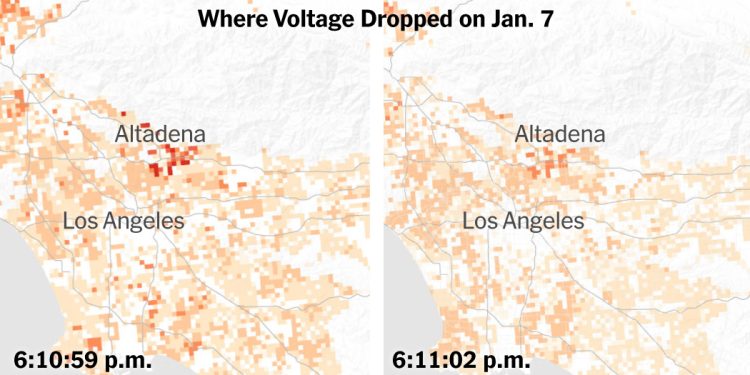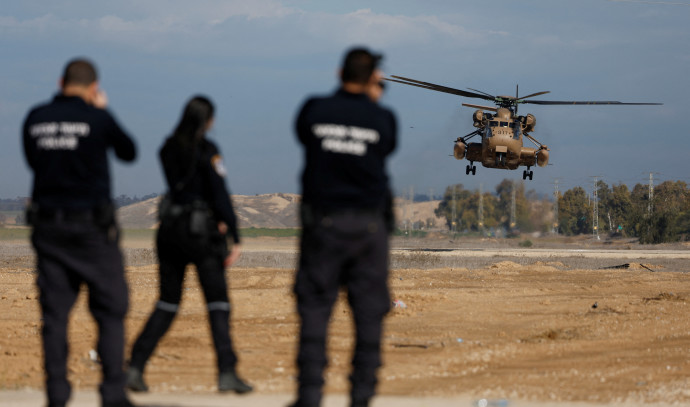A few moments before the flames burst below the transmission towers near Altadena, California, high voltage power lines are imposed in the region, show new sensor data, offering new indices on the issue of Knowing if public services equipment may have failed as Eaton Buried fire broke out on January 7.
Where the tension dropped on January 7, while the undoing electrical equipment
Source: Whisker Labs
Note: data is anonymized readings of houses that have installed laboratory sensors of mustaches.
About three seconds later, another major flaw was recorded near Altadena, according to Whisker Labs, which has a network of sensors installed in houses in the country which are collectively capable of measuring abnormal activity on the electricity network. The two electrical disturbances along the transmission lines were so powerful that they repercussions as far as Oregon and Utah, through tens of thousands of sensors.
“We watched this one-it was like, Holy Cow,” said Bob Marshall, co-founder and managing director of Whisker Labs. “This is an event at the transmission scale. Whenever something happens on the grid and we see a fault exactly at the same time on many sensors, so it’s a defect on the utility grid. »»
The faults at 6:10 p.m. and again at 6:11 p.m. coincided with two flashes near the transmission lines seen in a video captured by a camera in an Arco service station in the moments before the start of the fire Eaton, followed by flames near the Base of high voltage transmission laps.
The main drops of tension occurred at the same time as flashes called arcs
Images of the Arco service station
Source: Whisker Labs; Video: Images of surveillance of the Arco service station
Notes: Times are pacific.
Whisker Labs data, which does not provide conclusive evidence on the start of a forest fire, could play a central role by helping to determine the cause of the late Eaton, which has become more and more focused on failures Possible electricity on the transmission network in Eaton Canyon.
Combined with accounts of eye witness and a video of mobile phone of fire which rages under a set of three steel laps, the flashes in the video of the service station have focused attention on a transmission line belonging to Edison From southern California, the second utility belonging to state investors.
Edison did not concede that his equipment had caused Eaton’s fire, but said that he is carrying out his own investigation. The public service agreed to meet laboratories that watching data in the context of its exam. The exact cause of the fire, which killed 17 people and destroys more than 9,000 houses and businesses, remains under investigation and a final determination could take several months.
Electrical equipment – Transmission lines in particular – was the source of some of the most devastating forest fires in California and across the country. The fires caused by public service equipment has increased the risk and economic vulnerability for electricity suppliers, as extreme weather conditions focused on climate change have challenged the country’s aging electrical infrastructure.
In 2018, a live thread freed itself from a 100 -year -old transmission tower in strong winds and sparked the fire of the camp, which killed dozens of people and destroyed the city of Paradis in the North from California. Camp fire and a series of other flames have led the greatest public service in California, Pacific Gas & Electric, to file for bankruptcy in 2019 and to institute forest fire prevention measures while extreme weather conditions have become more persistent.
On the evening of January 7, the winds reached up to 100 miles per hour in southern California, based the trees and beating electric posts, towers and lines.
The WHISKER LABS network, a technological company based in Germantown, in MD., Has started to measure electrical problems in houses in the Los Angeles region using sensors, which help predict and prevent fires residential.
But two stood out. A major flaw on the electrical network in the Altadena and Eaton Canyon region caused a fall in tension a second before 6:11 p.m., then another, in the EDISS Gould and Goodrich deposit area, according to Whisker Labs .
The tension falls registered in a good place in the Altadena region and with a lower amplitude in other places across southern California. But the faults had been so substantial that their weakening impulses spread to a few milliseconds through the Western network of Whisker Labs – southeast in Phoenix; North in San Jose, California, and Portland, Ore.; Is in Las Vegas; And northeast in Salt Lake City.
Where tension has dropped elsewhere
Source: Whisker Labs
Notes: Times are pacific. The data concerns individual houses in the respective cities.
The extent of the two events suggested, according to Whisker Labs, that the defects were on the high-voltage transmission lines which transport the electricity of the installations such as power plants to stations. The low -voltage distribution lines, which provide the power of the electrical network to houses and businesses, experience defects more often in windy conditions, but they would not have the energy to send signals in the West.
When the power lines touch, enter into contact with posts or branches of trees or be swallowed up in smoke, they can produce flashes and sparks that can ignite the vegetation nearby.
The two flashes of Eaton Canyon recorded on the video of the service station at the same time as the two faults could represent the energy flash that occurs during a defect because the electricity disturbed on the line is looking for a place to go.
“All this energy – it is a lot of energy that entered this flash – it was enough energy for this to really lowered the tension of almost the entire Western grid, which means that it is a lot” said Marshall.
Robert McCullough of McCullough Research, a company based in Portland, Oregon, which carried out an examination of the data and the exploitation of Whisker Labs at the request of the Times, said that the data brought more the possibility that the utility equipment was involved in the outbreak of the Flamber Eaton.
“Everything we have had,” said McCullough, “we put in the same tower with the same relationships where we see unusual operations.”
In response to questions about the disturbances on his system, Edison said that he had recorded a fault at 6:11 p.m. in his Bould sub-station, an installation about five miles of what would be the point of origin of the fire. The usefulness then pointed out to state regulators that a preliminary analysis showed that because of the fault of the GELD sub-station, there was “a momentary and expected increase in the current of the SCE transmission system” .
But the company gave no indication that it recorded a large disruption in terms of the type transmission indicated in the new data compared to the Fire Eaton.
The public service said that he would meet representatives of Whisker Labs to examine the results.
“They approached us to discuss their data. We have agreed to meet them to revise them, because we will examine all the information at our disposal as part of our investigation, “said Kathleen Dunleavy, spokesperson for Edison. “If someone has evidence that can help the authorities determine the cause, we imply them to provide it immediately to the investigators.”
Edison said that he had measured a large fault on a transmission line linked to a separate fire, the Hurst fire, north of Altadena. This power line, in the Sylmar region of the County of Los Angeles, fell to the ground, although it is not clear if a power line caused the fire.
Whisker Labs sensors have also detected this incident.
A conclusion that Edison’s electrical equipment caused the Eaton fire could have important implications for the victims of the Eaton fire, which are looking for compensation for their losses and the future of the one of the main public service companies in the state. More than a dozen lawyers have brought prosecution against Edison, arguing that the assembly of evidence indicates the equipment of the public service as a source of the fire which devastated the community of Altadena.
“The fault data, the videos, the witness explains all paint the same image,” said Mikal C. Watts, a lawyer based in Austin, Texas, which represents some of the victims of forest fires.
The responsibility of the Eaton fire should exceed $ 10 billion, which could reduce Edison’s resources, insurance companies and even the state backup fund, which is designed to protect public services against responsibility.
The threat that electrical equipment poses to life and goods has led energy and safety experts to advance the power lines to be buried underground and to a wider use of technologies which can better detect problems on the network.
“We cannot make sure to get out of this problem,” said Michael Wara, director of the climate and energy policy at Stanford University. “We have to reduce risks.”
Blacki Migliozzi contributed the reports.


